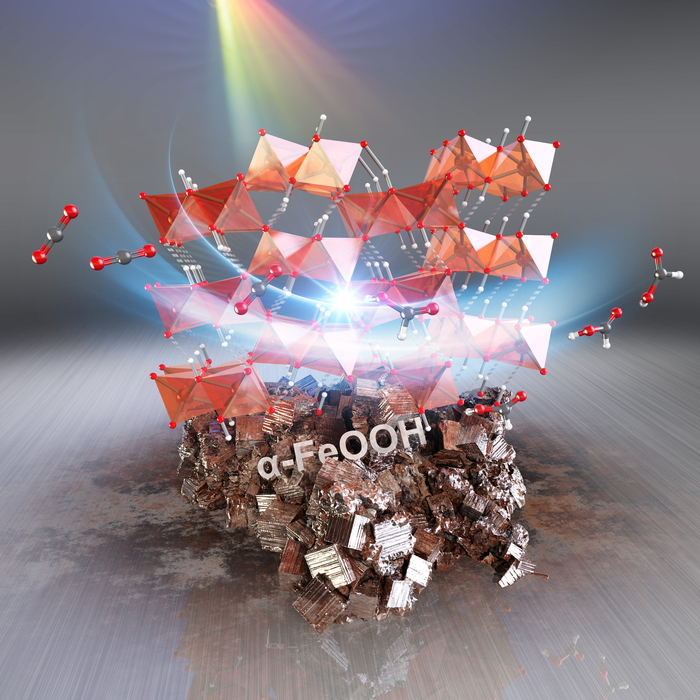Reviewed by Alex SmithMay 17 2022
CO2 photoreduction into a transportable fuel like formic acid (HCOOH) is an excellent strategy to combat growing CO2 levels in the environment.
 Carbon dioxide conversion into formic acid. A wide-spread soil mineral, alpha-iron-(III) oxyhydroxide, was found to become a recyclable catalyst for carbon dioxide photoreduction into formic acid. Image Credit: Tokyo Institute of Technology.
Carbon dioxide conversion into formic acid. A wide-spread soil mineral, alpha-iron-(III) oxyhydroxide, was found to become a recyclable catalyst for carbon dioxide photoreduction into formic acid. Image Credit: Tokyo Institute of Technology.
To help with this, a Tokyo Tech research team put an easily accessible iron-based mineral onto an alumina substrate to create a catalyst that can efficiently convert CO2 into HCOOH with ~90% selectivity.
CO2 levels in the atmosphere are growing, and their connection to global warming is now well-known. One effective option has arisen as researchers experiment with numerous approaches to combat this problem: turning extra atmospheric CO2 into energy-rich molecules.
The production of fuels such as formic acid (HCOOH) by photoreduction of CO2 under sunlight has lately received a lot of interest due to the two-fold benefit that this method can provide.
It can reduce excess CO2 emissions while also helping to alleviate the present energy shortfall. HCOOH can produce energy via burning while only releasing water as a byproduct since it is a great transporter of hydrogen with a high energy density.
To make this profitable option a reality, scientists created photocatalytic devices that use light to reduce CO2. A light-absorbing substrate (i.e., a photosensitizer) and a catalyst capable of enabling the multi-electron transfers necessary to convert CO2 into HCOOH make up such a system. Thus began the quest for an appropriate and effective catalyst.
Due to their efficiency and potential recyclability, solid catalysts were deemed the best candidates for this task, and the catalytic abilities of many cobalt, manganese, nickel, and iron-based metal-organic frameworks (MOFs) have been investigated over the years, with the latter having some advantages over other metals.
However, instead of HCOOH, most iron-based catalysts described so far only produce carbon monoxide as the major product.
Nonetheless, a team of Tokyo Institute of Technology (Tokyo Tech) researchers led by Prof. Kazuhiko Maeda quickly addressed the problem.
The researchers presented an alumina (Al2O3)-supported iron-based catalyst that utilizes alpha-iron (III) oxyhydroxide (-FeOOH; geothite) in a recent paper published in Angewandte Chemie. The new α-FeOOH/Al2O3 catalyst demonstrated outstanding CO2 to HCOOH conversion characteristics as well as recyclability.
We wanted to explore more abundant elements as catalysts in a CO2 photoreduction system. We need a solid catalyst that is active, recyclable, non-toxic, and inexpensive, which is why we chose a widespread soil mineral like goethite for our experiments.
Kazuhiko Maeda, Professor, Tokyo Institute of Technology
To make its catalyst, the researchers used a simple impregnation procedure. They employed the iron-loaded Al2O3 material for photocatalytic CO2 reduction at room temperature in the presence of a ruthenium-based (Ru) photosensitizer, an electron donor and visible light with a wavelength greater than 400 nm.
The results were promising. Their system had a selectivity of 80–90% for the major product, HCOOH, and a quantum yield of 4.3%, which indicates system efficiency.
When combined with an efficient photosensitizer, this study presents a first-of-its-kind iron-based solid catalyst that can create HCOOH. It also looks at the significance of a good support material (Al2O3) and how that affects the photochemical reduction process.
The findings of this study might assist in the creation of new catalysts for the photoreduction of CO2 into other valuable compounds that are devoid of precious metals.
Prof Maeda concluded, “Our study shows that the road to a greener energy economy does not have to be complicated. Great results can be attained even by adopting simple catalyst preparation methods and well known, earth-abundant compounds can be used as selective catalysts for CO2 reduction, if they are supported by compounds like alumina.”
Journal Reference:
An, D., et al. (2022) Alumina-Supported Alpha-Iron (III) Oxyhydroxide as a Recyclable Solid Catalyst for CO2 Photoreduction under Visible Light. Angewandte Chemie doi:10.1002/anie.202204948.